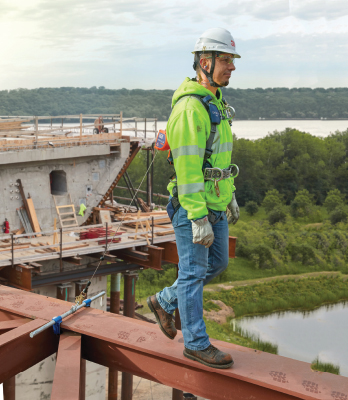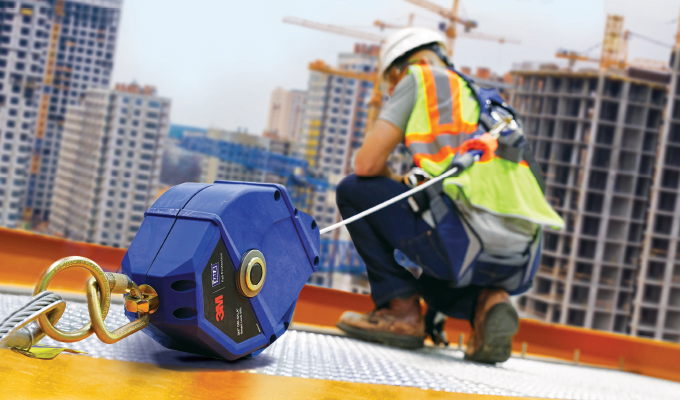The right equipment for leading and sharp edge situations
By Raymond Mann, QSSP, and Carly Engels Johnston
Working at height can be a risky business. That’s why many personal fall arrest systems rely on lifeline materials to perform in hazardous conditions where falls from height are a definite possibility. But there are some applications where use of the wrong product—for example, where a lifeline contacts a sharp or leading edge—can have disastrous results. That’s why its critically important to not only understand sharp and leading edge hazards, but to make sure you have the right equipment for these situations and that you use a fall protection system specifically designed to address leading edge hazards while working at height.
WHAT IS A SHARP EDGE?
A sharp edge is one that, for practical purposes, is not rounded and has the potential to cut and even completely sever most types of lifelines. An example of a sharp edge application is a steel beam with a ragged edge that has the potential to cut or sever a lifeline if a worker falls over the edge.
Do you know how sharp the edges are on your worksite?
The ANSI/ASSPZ359.14 standard states that for sharp edge certification, the lifeline of the fall arrest device must be tested over a piece of steel bar with a radius of no more than .005 inches. The device must arrest the test mass and the mass must not strike the ground.
WHAT IS A LEADING EDGE?
To visualize a leading edge, picture a worker installing decking substrate on a new building. Now imagine the worker’s fall protection system is anchored at foot level behind him, as is often the case. As the worker moves out and away from the anchor point while installing the decking, the worker is exposed to a potential fall over the edge of the decking.
WHAT ARE THE UNIQUE RISKS OF LEADING AND SHARP EDGE APPLICATIONS?
In sharp edge applications, the primary risk is that if the worker falls over the edge the lifeline can be frayed, cut or even severed, resulting in the worker falling to the level below. However, even a fall over a leading edge can pose risks in addition to the risks associated with a sharp edge, including:
Increased fall distances: When workers are attached at foot level, as they often are in leading edge applications, they will fall further than they would if they were anchored at shoulder height or directly overhead. The required clearance when anchored at foot level varies by product, so make sure to reference the manufacturer’s instructions prior to use.
Lock-up speed: Self-retracting lifelines (SRLs) react to a fall when the lifeline accelerates out of the housing at a certain velocity. But, when SRLs are anchored at foot level, the lifeline may not achieve the required acceleration during a fall until after the user’s D-ring passes over the leading edge and the user falls below the level of the anchor. This means the user may already have fallen about 5 feet or even more before the SRL device senses the event to engage and begin arresting the fall.
Increased fall arrest forces: Falling farther typically means a more severe impact when the fall is arrested.
Increased potential for swing fall hazards: While a swing fall is dangerous, the danger is compounded if the worker’s lifeline is extended over a sharp edge and the lifeline saws back and forth across the edge. This sawing action can lead to catastrophic events.
WHAT SHOULD YOU LOOK FOR IN LEADING AND SHARP EDGE FALL PROTECTION EQUIPMENT?
Previously, the industry responded to the hazards of leading and sharp edge situations by such methods as attaching an energy absorber to standard self-retracting lifelines, protecting edges, and elevating anchor points. While these efforts were helpful, many organizations have now decided to incorporate leading edge and sharp edge criteria into their standards (e.g., ANSI, CSA, and CE standards for self-retracting devices).
For example, ANSI has confirmed a number of assumptions through its testing and analysis, including the fact that products not specifically designed for foot level tie-off (the type of anchoring most often used in these applications) will generate forces far exceeding accepted safety parameters in the event of a fall. As an example, ANSI Z359.14 requires an external energy absorber to be an integral part of the SRL lifeline in order to accommodate additional impact forces involved in a foot-level fall event.

Manufacturers have also developed equipment to comply with the new standards to address the potential risks associated with leading and sharp edge situations. Product enhancements to address these challenges include manufacturing SRL cables out of stronger, more wear-resistance materials, using specialized energy absorbers, and employing features such as impact indicators to positively identify equipment that has been involved in a fall.
WHY IS TRAINING SO IMPORTANT?
While specially designed equipment is needed to help keep workers safe, fall protection products are only effective if crews understand how to use them and why they need it. Employers must deliver proper training so that workers fully engage and understand the unique hazards related to working at height in different applications.
CLOSING THOUGHT
The bottom line when it comes to leading edge and sharp edge applications is that employers should not only be aware of, and be able to identify, the risks and hazards associated with their jobsites, but they need to provide the appropriate fall protection equipment and training to help keep their workers safe while working at height in these specific situations.
About the authors:
Raymond Mann, QSSP, is a global senior specialist application engineer, fall protection technical services, regulatory and R&D at the 3M™ Personal Safety Division. Ray may be reached at ray.mann@mmm.com.
Carly Engels Johnston is a global writer and senior web journalist at the 3M™ Personal Safety Division. Carly can be reached at cejohnston@mmm.com.
Modern Contractor Solutions, February 2020
Did you enjoy this article?
Subscribe to the FREE Digital Edition of Modern Contractor Solutions magazine.



